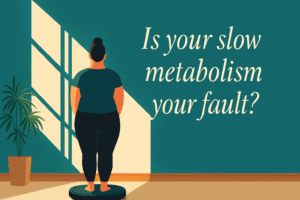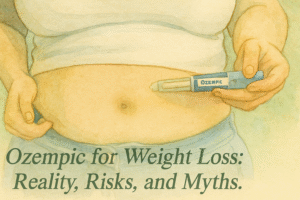‘Is there really a mathematical formula for health?’
“If you want to know whether you’re healthy or not, check your BMI- if it’s more than 23 you’re overweight- start dieting and if it’s below 17.5, you’re malnourished”, Dietician Poonam Sagar (DTPS) says, she always hear this, from people who think they need to change their diet because their BMI is too much, you can not just call someone healthy or unhealthy based on their height and weight.
It’s time we overcome such matrix of ‘This is how health works’.
BMI refers to Body Mass Index, it’s calculated as, BMI = weight(kg)/height(m)2.
The idea is simple, it tells you whether your weight is “appropriate” for your height. Based on your score, you fall into 1 of the 3 categories: underweight, normal, overweight, or obese. Sounds scientific and fantastic, right? Except, this formula is almost 200 years old.
BMI wasn’t created by a doctor. It was invented in the 1830s by Adolphe Quetelet, a Belgian mathematician and astronomer. He was interested in defining the “average man,” not in solving any medical condition. His formula = weight divided by height squared – seemed to work well in describing populations.
Almost a century later, life insurance companies started using height and weight tables to predict life expectancy. In 1972, American physiologist Ancel Keys revived Quetelet’s idea and named it the “Body Mass Index.” Since then, the World Health Organization (WHO) and governments adopted BMI as the official measure for obesity.
Then, why is it still used? Because its convenient. It works for large populations, is cheap and quick, and helps government bodies to categorize people.
So yes, BMI is convenient. But convenience is not the same as truth. Even Nuttall concludes that BMI is “a poor indicator of body fat” and should not be the only measurement for obesity.
“BMI is deeply flawed when used to judge individuals. Here’s why”- says DTPS;
- It can’t tell fat from muscle: A muscular athlete and a sedentary person may have the same BMI. One is fit, the other may not be – but BMI treats them the same.
- It ignores fat distribution: Belly fat (visceral fat) is far riskier for diabetes and heart disease than fat in thighs or hips. BMI can’t capture this difference.
- It varies by age, gender, and ethnicity: Indian and Asian populations tend to have more body fat at lower BMIs compared to Europeans. That’s why WHO lowered the BMI cut-off for obesity in Asians.
- It oversimplifies health risks: Recent studies show mortality risk is lowest not at “normal” BMI, but often in the so-called “overweight” range (24–28). So being slightly above “normal” may not be dangerous at all.
For Indians, BMI is trickier. Research shows that Indians have higher body fat percentage at lower BMIs compared to Western populations. That means someone with a BMI of 23 (technically “normal”) may already have unhealthy levels of fat around the liver or abdomen.
This is why Indian health guidelines often classify BMI of 23–24.9 as “overweight.” It reflects our genetic tendency toward central obesity – the infamous “belly fat.”
“What Should We Look At Instead?”, If you really want to understand your health risks, go beyond BMI:
- Waist circumference: A big belly is a red flag, even if your BMI is normal.
- Waist-to-hip ratio: Tells you where fat is sitting – belly vs hips.
- Body composition tests: Tools like bioelectrical impedance or DEXA scans measure fat and muscle more accurately.
- Blood tests: Cholesterol, sugar, triglycerides – these show what’s really happening inside.
India is already called the “diabetic capital of the world.” Relying only on BMI could be misleading. A person with BMI 22 may look fine but still be insulin resistant. Another with BMI 27 may be active, muscular, and metabolically healthy.
“Our healthcare approach must shift from a number obsession to a holistic assessment“- says DTPS.
Conclusion-
BMI was never designed to be the health oracle it has become. It’s a blunt tool that works for population averages but fails when applied to real, diverse individuals. For Indians, with our unique fat distribution and rising lifestyle diseases, BMI is just one piece of the puzzle – not the whole picture.
So, the next time someone points to your BMI and declares you “overweight” or “obese,” Look deeper: your waistline, your habits, your blood work. Health is more than a two-digit number or any x, y, and z.
Bibliography:
- Nuttall FQ. Body Mass Index: Obesity, BMI, and Health: A Critical Review. Nutr Today. 2015 May;50(3):117-128. doi: 10.1097/NT.0000000000000092. Epub 2015 Apr 7. PMID: 27340299; PMCID: PMC4890841.
- Montani JP. Ancel Keys: The legacy of a giant in physiology, nutrition, and public health. Obes Rev. 2021 Mar;22 Suppl 2:e13196. doi: 10.1111/obr.13196. Epub 2021 Jan 26. PMID: 33496369.







